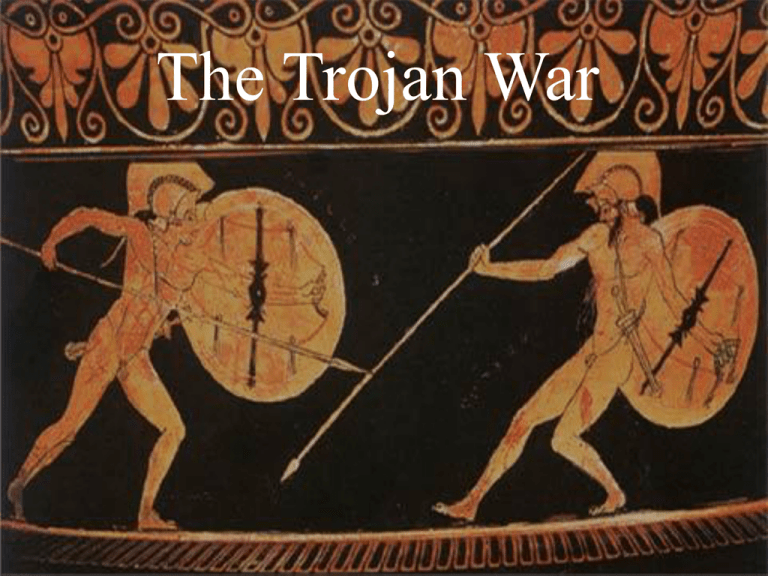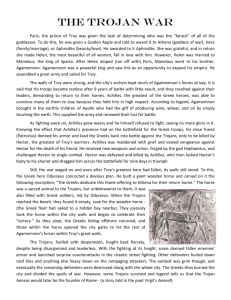Trojan War - MacEng11
advertisement

The Trojan War One of the most famous stories from the Classical World is the story about the Trojan War. The story, according to common belief, was written by the poet Homer. The story is told in Homer’s epic poem the Iliad. Homer, himself, may not have existed. Instead stories like the Iliad were most likely passed by word and mouth through many generations. The Trojan War arose out of a dispute between the goddesses Hera, Athena and Aphradite. They were guests at a wedding, when the goddess Discord threw a golden apple in their midst upon which was written ‘ for the fairest.’ Each of the three goddesses believed that she should have the apple. Zeus chose Paris, a prince of Troy, to judge which goddess should receive the apple. Eventually he chose Aphradite, who promised him the love of Helen, the most beautiful mortal woman,in return. Paris immediately went to Sparta, wooed Helen, and then returned to Troy with his new lover. This did not please the Greeks, for Helen was married to Meneleus, the king of Sparta. The Greeks mustered an army, and under the leadership of Agamemnon, the brother of Meneleus, prepared to sail to Troy. It is said that Helen was the face that launched a thousand ships, for that is how many eventually set sail for Troy. Troy was a well defended city, with walls, according to legend, built by Poseidon. The Greeks and the Trojans fought fiercely on the coastal plain, and although the Greeks won many battles they were unable to penetrate the defences of the Trojan city. The Greeks were supported by the goddesses Hera and Athena, and also benefited from the services of a number of mighty warriors within their ranks. The greatest of these was undoubtedly Achilles, whose mother had dipped him into the river Styx when he was a baby, thereby causing him to be virtually invincible in battle. Achilles, however, sometimes did not help his fellow Greeks in battle. Once he agued with Agamemnon over a slave girl and refused to fight. Nevertheless, he agreed to lend his armour to his friend Patroclus. Unfortunately, Patroclus, mistaken, for Achilles, was killed by Hector, the son of King Priam, and the greatest of the Trojan warriors. With Patroclus dead, Achilles vowed to avenge his friend’s death. Achilles quickly found his sworn enemy, and, following a fierce fight, Hector soon lay dead on the battlefield. Achilles tied Hector’s body to the back of his chariot and then drove in glorious triumph around the walls of Troy. After much beseeching by King Priam, Achilles eventually agreed to return Hector’s body to the Trojans. Despite Hector’s death, the Greeks were still unable to break down the defences of Troy. And then tragedy struck; Achilles was slain, shot in the heel by Paris. Held there by his mother, his heel had been the only part of his body not to have been dipped into the river Styx. The war reached its tenth year, and yet neither side could gain the upper hand. At last Odysseus, the king of Ithaca, came up with a cunning plan. He suggested that the Greeks should build a huge wooden horse, inside which fifty of the strongest warriors could be hidden. Agamemnon eventually agreed to this idea, and the horse was built. The chosen men, including Odysseus, climbed up into the belly of the horse, and the horse was left on the shore. The rest of the Greeks deserted their camp, and sailed to the other side of the nearby island, Tenedos. However, one Greek, named Sinon who was renowned for making up stories, was left with the horse to convince the Trojans that they should drag the Horse into their city. When the Trojans saw that the Greeks had gone away they were overjoyed, for they believed the war was finally over. However, they were in awe of the horse and were unsure what to do with it. Sinon, who explained he had been left as a deserter and a prisoner, told the Trojans that the horse had been built as an offering to the god Poseidon to provide them with a safe passage back to Greece. The Trojans were on the point of believing Sinon’s story when Laocoon, a priest of Troy, claimed the horse was a trick, and hurled a spear into the side of the huge wooden statue. Luckily for the Greeks hiding inside no one was hit. Almost immediately, a huge serpent appeared out of the sea and wrapped itself around laocoon and his two sons, dragging its wretched victims back under the waves. The Trojans, now left in little doubt that the horse was truly an offering to the god Poseidon, readily accepted Sinon’s story. The Trojans dragged the wooden horse into their city, unaware of the danger that was concealed inside the huge belly. Happy that the war was over the Trojans planned parties and celebrations that would last late into the night. They did not even bother to post guards on the ramparts, so sure were they that all danger of attack had passed with the departure of the Greeks. It did not take long for the Trojans to become drunk, and soon they all fell into a deep sleep. It was then that the warriors descended from the belly of the horse. They crept to the outer walls and opened the gates. Then they lit a fire on the ramparts as a signal to the rest of the Greeks, who in the meantime had returned to the mainland, that the plan had worked. The sleeping revellers were easy prey for the rampaging Greeks, and, with the city burning, the Trojans were slaughtered without mercy. The once proud city of Troy was reduced to a smoking ruin. The Greeks were victorious, Helen was restored to Meneleus. The Greeks prepared to sail back to their homelands – most completing the journey in little time. However, many years were to pass before Odysseus would see the shores of Ithaca again. Did any Trojan survive the Greek massacre? According to legend, prince Aeneas escaped from the burning city with his young family and his elderly father. The Roman poet, Virgil, would have us believe that Aeneas sailed to Italy and there founded a new settlement. From this settlement emerged the great city of Rome.




